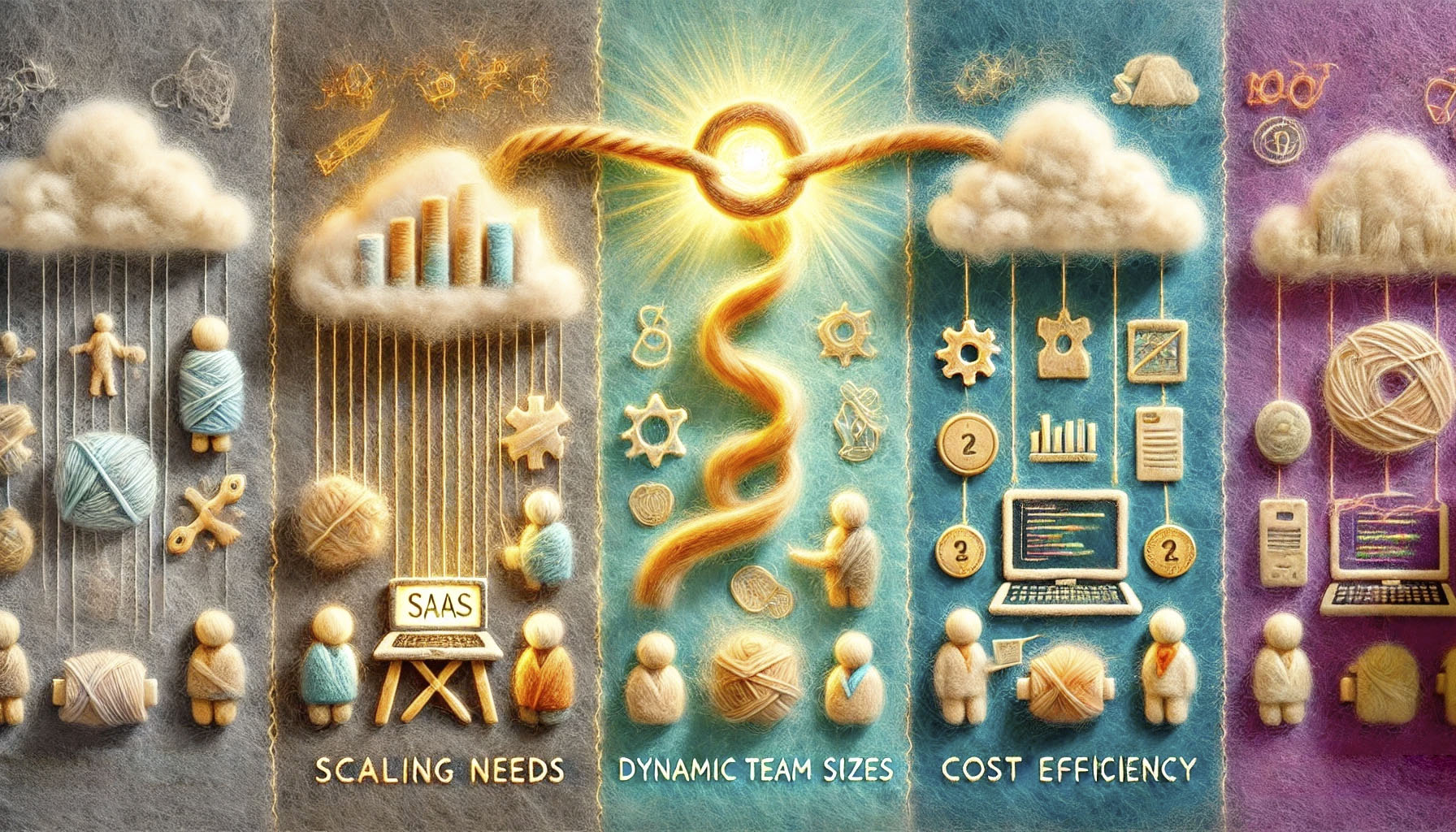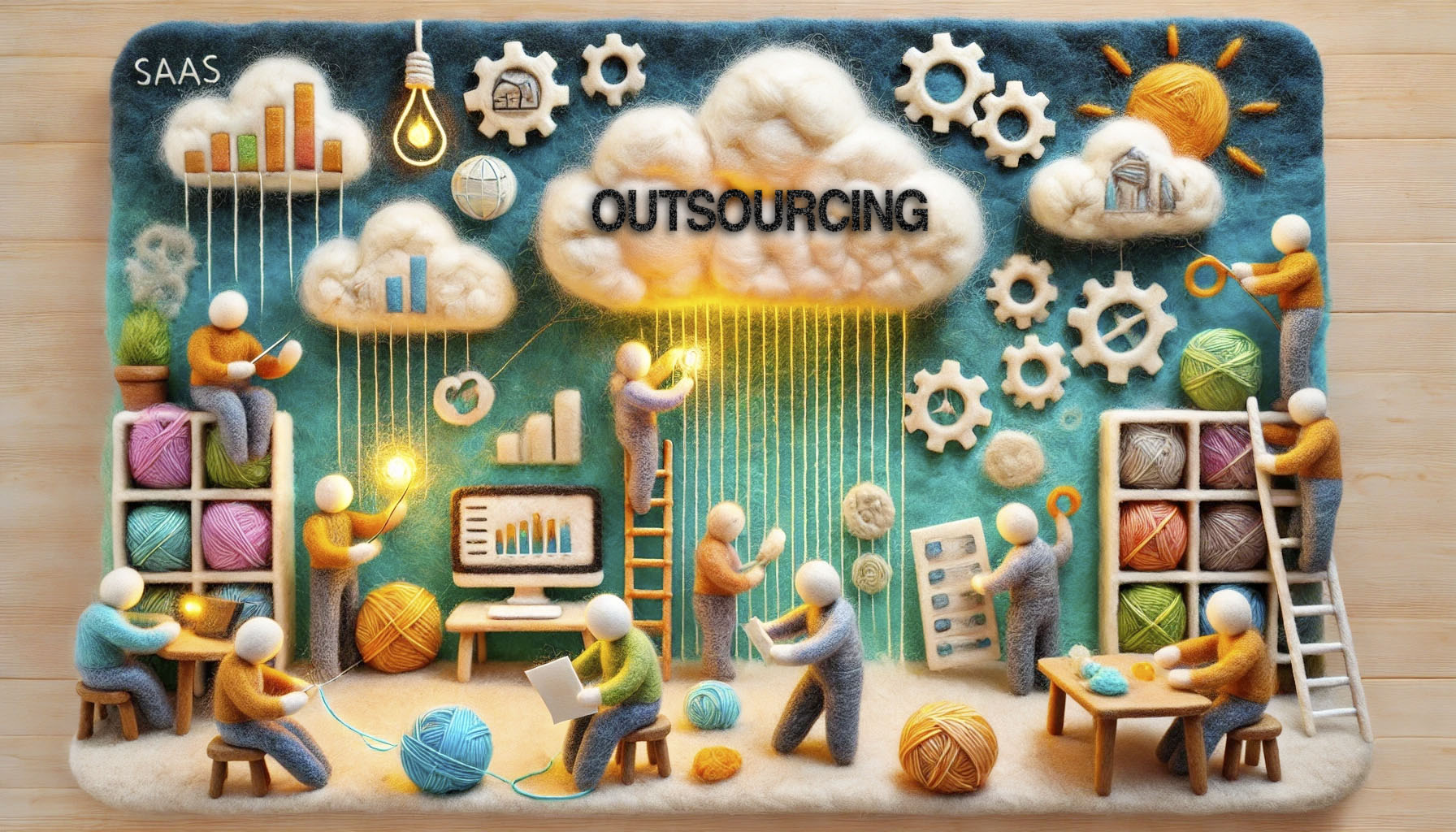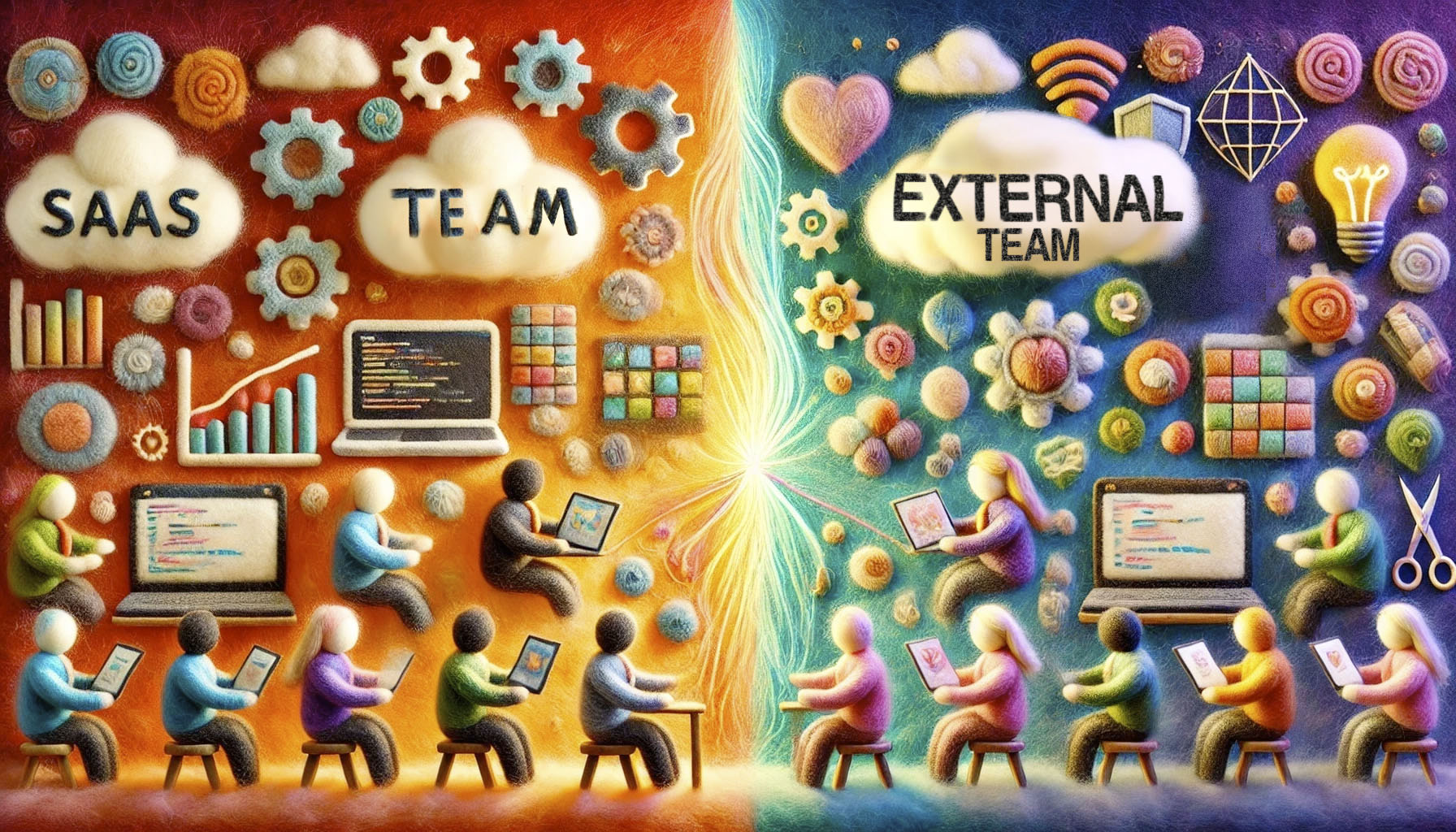SaaS growth unlocked with team augmentation

Introduction: The role of team augmentation in SaaS scaling
The SaaS industry is experiencing explosive growth. According to Paddle SaaS Market Report published in December 2024, B2C SaaS software growth showed an exceptional rebound, with a CAGR averaging 12.7%. This expansion is driven by the rise of cloud-based services, AI-powered personalization, and industry-specific SaaS platforms. However, scaling SaaS efficiently in this competitive environment presents challenges such as talent shortages, high development costs, and unpredictable market demands.
Scaling SaaS: Unlock growth with team augmentation — you are here
What is team augmentation in SaaS?
Team augmentation involves extending in-house teams by integrating external developers, designers, and specialists to meet project-specific demands. This flexible model supports SaaS companies in maintaining growth momentum by addressing skill gaps, boosting development capacity, and reducing operational overhead.
Why it matters
- Scalable growth. Companies can expand teams on demand, scaling up or down as needed.
- Cost efficiency. Saves recruitment, onboarding, and long-term hiring costs.
- Access to expertise. Connects businesses with global talent for niche technologies like AI, blockchain, and cybersecurity.
Purpose of this article
- Explain how team augmentation supports SaaS scalability.
- Compare outsourcing models with in-house teams.
- Highlight real-world success stories demonstrating ROI from team augmentation.
Benefits of flexible team scaling for SaaS
Scaling development teams is essential for SaaS companies competing in a fast-paced digital environment. Team augmentation provides an adaptive approach that addresses growth challenges, optimizes costs, and offers access to niche expertise. Here’s how this strategy drives SaaS success.
How we address SaaS growth challenges with team augmentation

1. Rapidly scaling teams to meet development timelines
In SaaS, speed is everything. Companies face tight deadlines for feature releases and product launches. Traditional hiring can take months, while team augmentation integrates experienced developers within weeks, ensuring timely project completion.
Example:
A SaaS startup launching a marketing automation tool onboarded a nearshore development team within three weeks, enabling them to meet a critical release deadline while maintaining quality.
2. Adapting team sizes to dynamic project demands
SaaS development demands fluctuate due to market changes, feature rollouts, or customer feedback. Team augmentation allows businesses to scale resources up or down without long-term commitments, ensuring optimal productivity and resource allocation.
Example:
An eCommerce SaaS provider hired additional front-end developers during the holiday sales season and scaled back afterward, reducing operational costs by 35%.
3. Reducing operational overhead associated with in-house recruitment and management
Hiring full-time employees incurs salaries, benefits, and infrastructure expenses. Team augmentation minimizes these costs by enabling project-specific engagements. Businesses pay only for required services, ensuring predictable budgets and streamlined operations.
Example:
A FinTech SaaS platform saved 40% on operating expenses by outsourcing specialized developers for short-term feature integrations, avoiding the costs of in-house hiring.
Cost and time efficiency

1. Lower costs compared to in-house hiring
Savings breakdown:
- Recruitment and onboarding. Traditional hiring can cost $4,000 to $7,000 per employee due to recruitment and training expenses.
- Benefits and perks. Full-time employees receive benefits such as insurance and paid leave, adding 30-40% to base salaries.
- Infrastructure costs. In-house hiring requires office space, equipment, and maintenance.
Solution:
Team augmentation eliminates these overheads, providing expert developers on demand at rates 20-50% lower than local salaries.
2. Access to nearshore or offshore talent pools for competitive pricing
Expanding globally unlocks skilled developers in regions with lower living costs, making team augmentation cost-effective. Companies benefit from specialized skills at competitive rates.
Example:
A SaaS analytics provider outsourced machine learning specialists from Eastern Europe, reducing development costs by 45% while maintaining high-quality standards.
3. Faster time-to-market through immediate availability of skilled resources
Deploying new features faster strengthens market presence. With team augmentation, SaaS companies access skilled professionals, reducing recruitment cycles from months to weeks.
Example:
An HR SaaS platform integrated backend developers within two weeks, launching new features six months ahead of schedule.
Access to niche expertise

1. Leveraging global talent for specialized needs
Emerging SaaS technologies such as blockchain, AI, and cybersecurity require domain-specific expertise. Team augmentation provides access to professionals with cutting-edge skills.
2. Tailored matching of developer skills to project requirements
Businesses can precisely match developers to project needs, reducing learning curves and maximizing efficiency. This customization enhances project-specific performance.
Example:
A healthcare SaaS startup hired HIPAA-compliant developers to ensure its patient management system met regulatory standards, passing audits with zero compliance issues.
3. Examples of niche skills commonly sought in SaaS
FinTech:
- Regulatory compliance experts. Ensure compliance with financial regulations.
- Secure payment integration specialists. Develop safe, efficient payment systems.
Healthcare IT:
- Privacy compliance developers. Build systems adhering to HIPAA and data privacy laws.
- Interoperability experts. Enable seamless data exchange between healthcare platforms.
AI & Machine Learning:
- Algorithm developers. Create predictive models and recommendation engines.
Blockchain technology:
- Smart contract developers. Implement decentralized applications and secure data protocols.
Cybersecurity:
- Security analysts. Protect sensitive data from breaches and fraud.
Outsourcing vs. In-house team dynamics

SaaS companies often face a strategic choice between building in-house teams, outsourcing development, or adopting a hybrid model. Each approach has distinct advantages and challenges that impact scalability, cost-efficiency, and adaptability. This section explores outsourcing dynamics, in-house team limitations, and the benefits of combining both approaches.
The case for outsourcing in SaaS
Outsourcing offers a flexible and scalable development model, especially for time-sensitive or resource-intensive SaaS projects. Here are the key advantages:
1. SaaS flexible scaling
- Dynamic scaling. SaaS companies can adjust team sizes according to project needs without long-term hiring commitments. This is crucial during peak development cycles or for temporary surges.
- Shortened timelines. Partnering with outsourcing firms that provide ready-to-deploy talent accelerates product launches and time-to-market.
2. Diversity in talent and ideas
- Global expertise. Accessing a global talent pool brings diverse skills, experiences, and innovative perspectives.
- Specialized skills. Outsourcing firms often provide niche expertise in emerging technologies like AI, machine learning, blockchain, and cybersecurity.
3. Risk-sharing
- Accountability. Established outsourcing providers implement quality assurance and follow proven development processes, reducing risks of delays or subpar results.
- Clear contracts. Service level agreements (SLAs) and detailed contracts ensure mutual understanding of deliverables, timelines, and quality expectations.
Limitations of in-house teams
While in-house teams offer direct control and alignment with company culture, they come with challenges that can hinder SaaS growth.
1. Challenges of SaaS scaling
- High recruitment costs and time investments. Hiring and onboarding in-house developers can take months, delaying critical projects. Recruitment expenses include job postings, interviews, and training programs.
- Rigid growth trajectories. In-house teams are harder to scale quickly, limiting the ability to respond to sudden market demands or project expansions.
2. Limited access to expertise
- Specialized skills gap. In-house teams may lack advanced technical expertise in areas such as DevOps, AI, or big data analytics.
- Knowledge stagnation. Without continuous training, in-house teams risk falling behind on emerging technologies and development practices.
3. Adaptability challenges
- Inflexibility in dynamic environments. Established internal processes can slow down a company’s ability to pivot and adapt to new market trends.
- High operational overheads. Salaries, benefits, office space, and continuous training contribute to significant recurring expenses, reducing cost-efficiency.
Hybrid models for optimized development

Hybrid models blend the strengths of in-house teams with outsourcing flexibility, creating a balanced and scalable SaaS development strategy.
1. Maintaining core expertise in-house
- Strategic alignment. Keeping essential roles in-house ensures that business goals and company values remain central throughout the project lifecycle.
- Knowledge retention. In-house teams safeguard key institutional knowledge, driving long-term product strategy and decision-making.
2. Augmenting with external talent
- Specialized tasks. Outsourcing niche tasks like cloud migrations or AI model development enables in-house teams to focus on strategic business priorities.
- Rapid scaling. Companies can quickly expand capacity during peak workloads by hiring external developers without committing to permanent hires.
3. Examples of hybrid SaaS development strategies
- Localized expertise. A SaaS company expanding into new regions can hire local outsourcing partners for language localization, compliance management, or market research while keeping core product development in-house.
- On-demand expertise. For short-term projects like integrating blockchain payment systems, companies can hire specialized developers while retaining control over the primary platform.
- Cloud integration models. Businesses may use third-party teams for temporary cloud infrastructure during testing phases, ensuring scalability without committing to full infrastructure ownership.
Cost comparison: In-house teams vs. Staff augmentation
When considering team augmentation for SaaS development, understanding the financial implications is critical. The following table illustrates a cost comparison between maintaining an in-house team and leveraging staff augmentation, highlighting key cost categories:
| Cost category | In-house costs (USD) | Staff augmentation costs (USD) |
| Base salary (monthly) | 4,600.0 | 7,000.0 |
| Recruitment costs (annual) | 192.0 | 0.0 |
| Health insurance & allowances (monthly) | 460.0 | 0.0 |
| Taxes (monthly) | 1,242.0 | 0.0 |
| Back-office expenses (monthly) | 138.0 | 0.0 |
| Training & development (annual) | 276.0 | 0.0 |
| Inefficiencies (annual) | 230.0 | 0.0 |
| Code reviews & tech leadership (annual) | 230.0 | 0.0 |
| Onboarding new developers (annual) | 92.0 | 0.0 |
| Total | 7,460.0 | 7,000.0 |
Key insights from the comparison
- Base salary difference:
- Staff augmentation typically comes at a higher per-resource base cost ($7,000/month compared to $4,600/month for in-house employees). However, this includes advanced expertise and avoids other in-house costs.
- Staff augmentation typically comes at a higher per-resource base cost ($7,000/month compared to $4,600/month for in-house employees). However, this includes advanced expertise and avoids other in-house costs.
- Overhead savings with augmentation:
- Recruitment costs, health insurance, allowances, and taxes add significant overhead to in-house hiring. These are entirely eliminated with staff augmentation.
- Recruitment costs, health insurance, allowances, and taxes add significant overhead to in-house hiring. These are entirely eliminated with staff augmentation.
- Avoidance of back-office expenses:
- Back-office expenses like administrative support and office utilities are part of in-house team maintenance, which can accumulate over time. Staff augmentation does not incur such costs, making it a leaner option.
- Back-office expenses like administrative support and office utilities are part of in-house team maintenance, which can accumulate over time. Staff augmentation does not incur such costs, making it a leaner option.
- Reduced training & development costs:
- While training and upskilling are essential for in-house teams, staff augmentation provides ready-to-deploy talent, eliminating the need for additional investment in training.
- While training and upskilling are essential for in-house teams, staff augmentation provides ready-to-deploy talent, eliminating the need for additional investment in training.
- Efficiency and speed:
- Staff augmentation avoids inefficiencies related to onboarding and code reviews, allowing teams to integrate skilled resources faster and focus on productive tasks.
Strategic implications for SaaS companies
While in-house teams may offer direct control and long-term stability, staff augmentation emerges as a flexible and cost-effective alternative for short- to medium-term project needs. SaaS companies can save up to 6.2% on total costs with staff augmentation, alongside benefits such as reduced recruitment timelines and access to niche expertise.
Real-life examples of successful SaaS scaling strategies
Scaling a SaaS company is no easy feat. From launching new features and expanding into global markets to bridging skill gaps, SaaS businesses often face high-pressure situations. Here are three real-world stories of companies that scaled successfully by staying flexible and thinking strategically.
SaaS startup – from idea to MVP, fast
The challenge:
A SaaS startup with a promising project management tool idea faced intense investor pressure to launch an MVP quickly. Building an in-house team was too slow and expensive to meet tight deadlines.
The move:
They hired a nearshore development team skilled in both frontend and backend technologies. These professionals integrated seamlessly, skipping lengthy onboarding processes and delivering results immediately.
What worked:
- The external team used React for the frontend and Node.js for the backend — no hand-holding needed.
- Collaboration was smooth thanks to Slack and Jira, ensuring synchronization between the in-house and nearshore teams.
- The startup’s core team could focus on product strategy and market feedback instead of recruitment and training.
The win:
The MVP launched 40% faster than expected. Investors were thrilled, early adopters came on board, and development costs were cut by 30%.
Takeaway:
When speed and cost-efficiency are critical, external talent can help you scale without stretching your team too thin or blowing the budget.
Enterprise SaaS – going global without stumbling
The challenge:
A U.S.-based enterprise SaaS giant aimed to expand into international markets but needed to adapt to local languages, regulations, and customer expectations.
The move:
The company partnered with local specialists for two core functions:
- Compliance. Ensuring data security compliance with region-specific regulations like GDPR in Europe.
- Localization. Tailoring the platform’s language, interface, and messaging to resonate with diverse user bases.
What worked:
- Local consultants helped the company avoid legal and cultural pitfalls.
- Fully localized marketing and support materials created a seamless user experience.
- Regional teams provided constant market-specific feedback, enabling faster product updates.
The win:
Adoption rates skyrocketed, and nearly 40% of the company’s revenue now comes from international users.
Takeaway:
Global expansion is about tailoring your product to local markets. Partnering with regional experts ensures cultural, linguistic, and regulatory success.
Overcoming skill gaps – AI features, without the hassle
The challenge:
A mid-sized SaaS company wanted to turn its massive customer data into valuable insights by adding AI-powered analytics. Lacking AI talent in-house, they needed specialists fast.
The move:
Rather than hiring full-time AI engineers, the company opted for short-term staff augmentation. They brought in AI experts familiar with TensorFlow and PyTorch to build predictive models and advanced analytics.
What worked:
- AI specialists developed features like timeline forecasts and team optimization models.
- The internal team learned AI best practices along the way, gaining lasting skills.
- Development was completed in three months — half the time it would’ve taken with only in-house resources.
The win:
The new AI-powered features impressed enterprise clients, driving a 25% increase in customer acquisition within six months. The company avoided long-term costs by hiring only for the duration of the project.
Takeaway:
When skill gaps threaten innovation, bringing in specialists for short-term sprints can fast-track results without long-term commitments.
What these stories teach us
Scaling a SaaS business is a marathon with sprint intervals. These examples reveal a few winning strategies:
- Startups can hit MVP goals faster by leveraging external talent.
- Enterprises can expand globally by partnering with local experts.
- Companies facing skill gaps can hire short-term specialists for cutting-edge innovation.
Key considerations for effective scaling of your SaaS with team augmentation
Bringing in external talent shouldn’t feel like throwing people into the deep end and hoping they swim. Successful team augmentation is about building trust, defining clear processes, and ensuring long-term knowledge retention. Whether you’re expanding a SaaS startup or scaling a global enterprise, here’s how to make external collaboration seamless and impactful.
1. Finding the right partner
Choosing the right team augmentation partner is less about resumes and more about compatibility. You need technical expertise and a working relationship that fits your culture and goals.
Start by assessing their technical skills. Do they excel in the frameworks your stack relies on, like React, Node.js, or Python? Have they built SaaS products with CI/CD pipelines and cloud infrastructure? Case studies and client testimonials can reveal more than sales pitches ever will.
But it’s about chemistry. Schedule “get-to-know-you” calls with their developers and managers. If conversations flow easily and problem-solving feels collaborative, you’re likely onto something promising.
What matters. Look for a partner that’s more than a vendor — they should be an extension of your team, invested in your long-term success.
Managing external teams like pros

Integrating an augmented team into your workflow can feel tricky, especially when they’re halfway across the world. The secret? Clear communication, defined roles, and consistent project management practices.
Weekly check-ins and sprint reviews ensure that no one feels disconnected. Use project management tools like Jira or Trello to assign tasks and track progress visibly. Sync across time zones by aligning critical meetings with overlapping work hours and using asynchronous updates for everything else.
Define what success looks like from day one. Establish clear project scopes, timelines, and key deliverables. When everyone knows the game plan, collaboration feels seamless, even across borders.
What works. Communicate often, be explicit about expectations, and ensure everyone stays in the loop through structured processes.
Keeping knowledge alive after the project ends
Finishing a project isn’t the same as wrapping it up well. Without a proper knowledge transfer, you risk losing valuable context, slowing future development, or even repeating past mistakes.
Make documentation a standard practice, not an afterthought. Use shared platforms like Confluence, Notion, or Google Docs to store technical specs, design decisions, and best practices. Encourage developers to log updates regularly instead of cramming documentation at the project’s end.
Before saying goodbye, hold walkthrough sessions where the external team explains their work in detail. Pair programming can also help transfer skills directly to your internal developers.
Why it matters. Good knowledge transfer keeps progress from stalling when people move on. It’s about making sure your team knows where to find it when they need it.
The future of SaaS team augmentation: Sustainability at the core
Sustainability suddenly turned from a trendy add-on to a defining principle. SaaS companies are learning that scaling is first of all meaning growing responsibly. Team augmentation, a go-to strategy for scaling efficiently, is evolving with this mindset. The future lies in long-term partnerships, environmentally conscious development, and smarter scaling decisions.
Rethinking partnerships: Long-term over transactional
The old model of outsourcing as a quick fix is fading. More SaaS companies are opting for deeper, lasting relationships with external teams. Why? Because true collaboration goes beyond hitting deadlines and builds shared accountability and long-term success.
When external teams become familiar with your workflows, tools, and even company culture, onboarding becomes seamless, and collaboration hits a deeper level. Companies are also investing in external team development, offering training and career growth, which boosts commitment on both sides.
Imagine working with a team that not only delivers what’s asked but also suggests ways to reduce technical debt, improve efficiency, and cut costs. That’s the value of partnership.
Scaling sustainably: Greener SaaS practices
Scaling doesn’t have to come with a hefty environmental price tag. SaaS companies are increasingly aligning growth strategies with sustainability goals. The shift is already happening in three key areas:
1. Smarter cloud usage
Dynamic cloud resource allocation keeps servers from running idle, reducing wasted energy. Some SaaS businesses even choose data centers powered by renewable energy, minimizing their carbon footprint.
2. Remote-first models
Remote teams reduce carbon emissions by eliminating commutes and scaling without expanding physical spaces. A globally distributed team can function without the environmental toll of traditional office setups.
3. Energy-efficient development
Clean, optimized code means lighter server loads, faster performance, and lower energy consumption. Serverless architectures like AWS Lambda scale only when needed, reducing unnecessary compute power and keeping operations lean and green.
Sustainability as a business advantage
Sustainability is about staying competitive. Today’s enterprise clients and investors prefer companies committed to sustainability. A visible eco-strategy can strengthen a brand’s reputation, attract socially conscious customers, and even open the door to greener investment opportunities.
Regulations are also tightening, making compliance a strategic necessity. Businesses that act now can avoid costly adjustments later while gaining an edge in competitive SaaS markets.
Consider a SaaS company expanding globally while keeping sustainability front and center. By partnering with nearshore teams, reducing travel emissions, and hosting on renewable-powered servers, they achieve growth goals while meeting eco-commitments — a win-win scenario.
Team augmentation as a sustainability driver
Augmented teams play a pivotal role in this shift toward sustainable SaaS growth. They’re inherently remote, eliminating the need for costly, carbon-heavy office expansions. Their specialized expertise helps implement scalable, energy-efficient architectures like microservices and serverless computing.
Looking ahead: Growth with purpose
The future of SaaS team augmentation is clear: it’s not just about expanding capabilities but doing so with purpose. Long-term partnerships, environmentally conscious practices, and tech-powered sustainability will define the next era of SaaS growth. Companies that adopt these principles now will be ready for a future where sustainability is more a standard than just a responsibility.
Rethink team augmentation as the source of success for scaling SaaS
Team augmentation means unlocking the potential of your SaaS business. By blending in-house expertise with specialized external talent, your company can bridge skill gaps, accelerate development, and adapt to shifting market demands without the core team overextension.
What makes this approach powerful is its flexibility. Whether scaling globally, adding niche skills, or streamlining operations, augmented teams provide the agility needed to remain competitive.
Emerging talent hubs, smarter collaboration models, and sustainable scaling practices are reshaping how businesses expand. SaaS companies that embrace this new wave of team augmentation scale smarter, creating lasting value while staying competitive in a rapidly evolving industry.
Egor Kaleynik
IT-oriented marketer with B2B Content Marketing superpower. HackerNoon Contributor of the Year 2021 Winner – MARKETING. Generative AI enthusiast.
Featured in: Hackernoon.com, Customerthink.com, DZone.com, Medium.com/swlh
More info: https://muckrack.com/egor-kaleynik